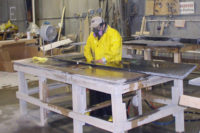On March 24, 2016, the U.S. Occupational Safety & Health Administration (OSHA) published a final workplace exposure standard for crystalline silica, reducing the permissible exposure limit (PEL) from 100 µg/m3 for an eight-hour time-weighted average to 50 µg/m3. The rule establishes two standards, where only one existed previously. OSHA’s Silica Rule will go into effect on June 23, 2016.
It is crucial to remember that this is not a consumer issue; the presence of silica in natural stone does not have an impact on consumer well-being. This is an issue of employee safety. While silicosis is incurable, it is preventable. If there is one key theme important to employee safety, it is that silica exposure must be measured to ensure you are protecting workers and have the necessary data to plan your company’s silica compliance plan.
Understanding the two standards in OSHA’s Silica Rule
OSHA’s Silica Rule is broken into two standards: one for construction and one for the general industry. When installing and restoring stone in the field, stone companies should follow the construction standard. When cutting stone in a fabrication, cut stone or production facility, the general industry standard applies. Note: quarriers should continue following MSHA guidelines in the field and OSHA general industry guidelines in production facilities.
General Industry and Maritime Standard
Companies that fall into the general industry category must comply with all requirements by June 23, 2018.
• Measure the amount of silica that each employee is exposed to in an eigth-hour day. If at or above 25 µg/m3 protective measures are required. Note: this is a time-weighted average.
• If respirable crystalline silica exposure is over 50 µg/m3, additional protective measures must be taken, including the following:
• Limiting workers’ access to areas where they could be overexposed
• Using dust controls to protect workers from silica exposures above the PEL
• Providing respirators to workers when dust controls cannot limit exposures to the PEL
• Restricting housekeeping practices that expose workers to silica when feasible alternatives are available
• Establishing and implementing a written exposure control plan that identifies tasks that involve exposure and methods used to protect workers
• Offer medical exams (including chest x-rays and lung function tests) every three years to workers exposed at or above the action level for 30 or more days per year.
• Maintain good training and recordkeeping practices. MIA+BSI has a variety of training resources and recordkeeping templates available online.
Construction Standard
Companies that fall into the construction category must comply with all requirements by June 23, 2017. Note: This is one year earlier than the general industry standard.
• Employers who follow specific guidelines may not be required to measure workers’ exposure; this may be beneficial for smaller employers. More information on these guidelines (“OSHA’s Table 1”) can be found at www.naturalstoneinstitute.org/silica.
• Employers who are not following the guidelines outlined in Table 1 must adhere to the following guidelines:
• If respirable crystalline silica exposure is over 50 µg/m3, additional protective measures must be taken, including the following:
• Limiting workers’ access to areas where they could be overexposed
• Using dust controls to protect workers from silica exposures above the PEL
• Providing respirators to workers when dust controls cannot limit exposures to the PEL
• Restricting housekeeping practices that expose workers to silica when feasible alternatives are available
• Offer medical exams (including chest x-rays and lung function tests) every three years to workers exposed at or above the action level for 30 or more days per year
• Maintain good training and recordkeeping practices. MIA+BSI has a variety of training resources and recordkeeping templates available online.
Industry action plans
Some in the stone industry view the new silica standard as unobtainable, costly and disruptive. Others argue that OSHA should have instead focused on crafting new and innovative ways to get more companies to comply with the current silica standard, which has played a huge role in reducing the number of silicosis cases in the past 40 years. Perhaps you’re wondering: “What is the construction and stone industry doing to fight against the OSHA Silica Rule?”
On March 31, 2016, MIA+BSI and NSC joined the Construction Industry Safety Coalition (CISC), a coalition of trade associations that joined together to financially support litigation, which was filed in Federal Circuit Court to challenge several aspects of the OSHA rule. The strategy is to get OSHA to negotiate implementation of the rule, including costs of engineering controls and medical exams.
Legislative outreach is also being conducted in order to influence OSHA appropriations from Congress. Congressman Bill Huizenga has authored a letter to House departments of Labor, Health and Human Services, and Appropriation leaders requesting language to prohibit funding for the silica rule. The letter has been signed by over 70 representatives and a similar letter is at work in the Senate. We recommend that those in the stone industry reach out to legislators to let them know you have grave concerns about the new OSHA rule.
Regardless of whether the OSHA rule goes into effect as planned or is held up by litigation or appropriation tactics, this is an excellent time for companies to review safety training programs and see what enhancements can be made to protect workers from silica exposure. There are a number of training resources available through MIA+BSI, including Toolbox Talks, educational videos and training guidelines. Utilize the resources developed by the safety committee, and know that more resources are coming soon.
With over 1,700 pages in the OSHA ruling, there will be necessary clarifications as stone professionals dig into the new standard. MIA+BSI will continue to monitor the ruling and offer tips and perspectives.
MIA+BSI has created an information webinar designed to help companies better understand the OSHA Silica Rule and the action plan surrounding it. To learn more about the OSHA Silica Rule, please visit www.naturalstoneinstitute.org/silica.
This article was written by MIA+BSI








